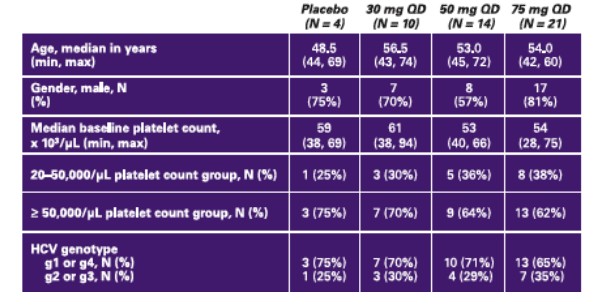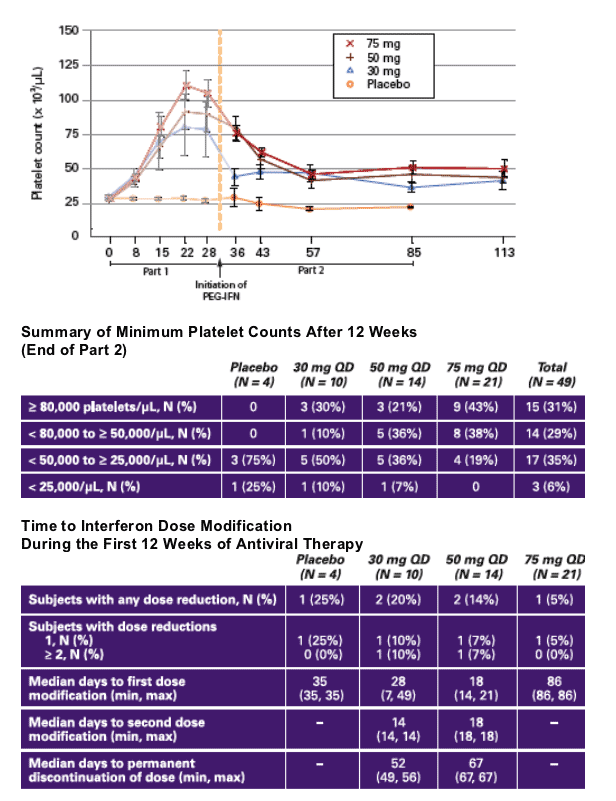 |
 |
 |
| |
Eltrombopag Maintains Platelet Counts During Myelosuppressive Pegylated Interferon Alpha Treatment of Chronic Hepatitis C Virus Infection
|
| |
| |
Reported by Jules Levin
DDW May 2007, Wash DC
G.M. Dusheiko1, J.G. McHutchison2, N.H Afdhal3, M.L Shiffman4, M. Rodriguez-Torres5, S. Sigal6, M. Bourliere7, T. Berg8, N. Blackman9, F.M. Campbell10, S. White9, D. Theodore11
1Royal Free Hospital, London, United Kingdom; 2Duke Clinical Research Institute, Durham, NC; 3Beth Israel Deaconess Medical Center, Boston, MA; 4Virginia Commonwealth University Health System, Richmond, VA; 5Fundacion de Investigacion de Diego, San Juan,
Puerto Rico; 6Weill Medical College of Cornell University, New York, NY; 7Hopital Saint Joseph, Marseille, France; 8Charite, Berlin, Germany; 9GlaxoSmithKline, Philadelphia, PA; 10GlaxoSmithKline, Greenford, United Kingdom; 11GlaxoSmithKline, Research Triangle Park, NC
Background
Eltrombopag is an oral, non-peptide, small-molecule thrombopoietin receptor agonist.
The safety, efficacy, and pharmacokinetics of eltrombopag in hepatitis C virus (HCV)-infected patients with thrombocytopenia precluding initiation of pegylated interferon (PEG-IFN) and ribavirin have been reported (McHutchison et al. 57th AASLD. 2006; Abstract LB3).
In study TPL102357, eltrombopag monotherapy was shown to increase platelet counts to > 100,000/_L at Week 4 in a dose-dependent manner (overall P value < 0.0001 for treatment effect). This effect was statistically significant versus placebo, with no patients in the placebo group achieving platelet counts > 100,000/_L.
As a result, two-thirds of patients were able to initiate their antiviral treatment [N = 49: 4/18 (22%) in the placebo group; 10/14 (71%), 14/19 (74%), and 21/23 (91%) in the 30-mg, 50-mg, and 75-mg eltrombopag groups, respectively].
Objectives
We examined the ability of eltrombopag to counteract the myelosuppressive effects of PEG-IFN on platelet counts in HCV-infected patients during antiviral treatment phase.
We analyzed a subset of the data from study TPL102357 to determine if eltrombopag is able to sustain platelet counts in thrombocytopenic patients during PEG-IFN treatment, to avoid the deleterious consequences of reductions in PEG-IFN dosing.
Rationale
There is an unmet need for a safe and effective treatment of disease and IFN-associated thrombocytopenia in HCV-infected patients to help facilitate optimal antiviral treatment.
Limited yet promising data with alternate thrombopoietic agents suggest that there is a potential role for eltrombopag in HCV-infected patients (Rustgi et al. 53rd AASLD. 2002; Abstract 791. Ghalib et al. Hepatology. 2003;37:1165-1171).
Safety, tolerability, pharmacokinetics, and pharmacodynamics were assessed in a phase I trial of eltrombopag 75 mg, administered once daily for 10 days in healthy volunteers (Jenkins et al. Blood. 2007;109(11): in press).
-- Eltrombopag was well tolerated and exhibited a linear pharmacokinetic profile.
-- A dose-dependent increase in platelet count was observed beginning on Day 7.
Methods
Double-blind, placebo-controlled study to evaluate the effects of eltrombopag on the initiation and subsequent maintenance of IFN-based antiviral therapy.
74 HCV-infected patients with platelet counts between 20,000 and 70,000/_L were randomized to receive eltrombopag (30, 50, or 75 mg daily) or placebo for 4 weeks. The primary endpoint was a platelet count increase to 3> 100,000/_L at Week 4. Patients could then initiate PEG-IFN and ribavirin and continue eltrombopag or placebo for 12 additional weeks.
49 patients entered this antiviral treatment phase and these data are now presented.
Eligibility Criteria
--Male or female patients 3 18 years of age.
-- Chronic HCV infection (detectable HCV RNA).
--Compensated liver disease (Child-Pugh A classification).
--Pre-existing thrombocytopenia: 20,000-70,000 platelets/_L.
--Patients stratified by baseline platelet count: 20,000-50,000/_L and >50,000-70,000/_L.
--No history of thrombosis, HIV, or active infection with hepatitis B.

RESULTS
Demographics (N = 49)
Median baseline platelet count was 59,000 in placebo, 61,000/ul in 30mg QD group, 53,000/ul in 50mg QD group, and 54,000/ul in 75mg QD group. 25-38% of study participants had 20 to 50,000/ul platelet count.


Conclusions
Eltrombopag effectively maintained platelet counts above 50,000/_L in up to 81% of patients during the first 12 weeks of antiviral treatment, counteracting the myelosuppressive effects of PEG-IFN.
Eltrombopag use avoided the need for PEG-IFN dose modification in approximately 90% of patients during the first 12 weeks of antiviral treatment.
Further research into the long-term use (48 weeks) of eltrombopag in patients with HCV-associated thrombocytopenia is warranted.
|
| |
|
 |
 |
|
|